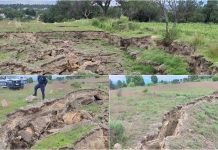Now, cracks in the ground have been photographed southwest of Reykjavik, Iceland.

The team of Warm Arctic, an icelandic company spezializing in geothermal reservoir engineering, has pictured dozens of cracks in the ground, where an earthquake swarm is currently hitting the Reykjanes Peninsula…
The present geological context and history
Experts believe a volcanic eruption could take place in the Reykjanes Peninsula.
A large volume of magma is accumulating in this area of Iceland since about a year, causing the soil to lift by several centimeters and triggering numerous seismic swarms, getting always stronger.
Since February 24, the situation has completely degenerated. Over 22,000 earthquakes have been recorded… Volcanic tremors too, prompting officials to raise the alert level of the Krysuvik volcano from green to orange overnight.
Yesterday, a M5.7 and 6 M4is hit the region within the same hour… InSAR reveals ongoing dike formation in Fagradalsfjall on the Reykjanes peninsula.
Successive InSAR data of the Iceland crisis. The first includes the M5.7 earthquake, a few other offsets, and clear dike deformation, the second indicates dike migration to the southwest and shows the surface rupture of the M5 event last night (S1, desc., by Adriano) @ESA_EO pic.twitter.com/XHu4OHeTo0
— Sigurjón (Sjonni) Jónsson (@Sjonni_KAUST) March 7, 2021
Now, cracks have been found in the Thorbjorn area, a small volcanic building formed during a single eruptive event that took place around 24,000 years ago. That exact same volcano made the headlines last year because it was the center of the first crustal deformations (caused rising magma).
Interesting low frequency earthquake. The long LF coda indicates movement of volcanic fluids. As magma ascends, moving toward the surface, gases build pressure within the magma, forcing cracks and dikes to open and expand through the overlying rocks.#icelandquakes #Iceland pic.twitter.com/htpGT1rLWr
— iikka lehtinen (@ilel100) March 7, 2021
These fractures were observed near the Blue Lagoon, a geothermal area and one of Iceland’s most visited tourist attractions. Its water comes from the nearby Svartsengi geothermal plant, or better said, the volcanic system located west of Krysuvik.
Surface cracks everywhere! Gunnar Grímsson and colleagues were in the field southwest of Reykjavík yesterday for drone imaging. Here is one of their shots. pic.twitter.com/9B8amozZwG
— Sigurjón (Sjonni) Jónsson (@Sjonni_KAUST) March 8, 2021
Thorbjorn and Krysuvik haven’t erupted for centuries. So there’s lot of magma ready to blow and flow!
Meanwhile some argue the volcanoes will not erupt:
When seismic tremor indicates magma is moving, concern about an #eruption is understandable.
But, eroded #volcanoes in East #Iceland show that over 80% of magma movements do NOT produce eruptions: they form dykes.
Pro tip. Most of the spreading in Iceland occurs underground ? pic.twitter.com/Wq6IIbhevo
— Dave McGarvie (@subglacial) March 7, 2021
What’s your opinion?
Did you know that giant cracks are also fissuring the desert of Arizona?
Now subscribe to this blog to get more amazing news curated just for you right in your inbox on a daily basis (here an example of our new newsletter).
You can also follow us on Facebook and/ or Twitter. And, by the way you can also make a donation through Paypal. Thank you!
You should really subscribe to QFiles. You will get very interesting information about strange events around the world.














We just entered a Grand Solar Minimum much like the Maunder Minimum of 1645 to 1715. Dr Valentina Zharkova has said the Sun’s magnetism is reduced during a GSM. This allows more cosmic rays (nuclear particles from distant stars) to enter our atmosphere. Some of the particles increase cloud cover and lead to more rain, hail and snow. Some of the particles strike the earth and energize volcanoes and earthquakes. In 1709 3 volcanoes erupted in Europe. They sent up so much ash into the atmosphere that sunlight was partially blocked. It cause the Big Freeze of 1709. The ground for the meter (nearly 40 inches) was frozen. It spiked food prices 600%. Iceland in the past has had massive starvation due to volcanoes so this is a sore subject for them. The world has 7 billion more people now than in 1709. I wrote about this: 2020s: Surviving The Cold, The Quakes And Volcanoes
https://vidrebel.wordpress.com/2019/12/30/2020s-surviving-the-cold-the-quakes-and-volcanoes/
1968 I was stationed Naval Communications Station Keflavik for a year. Daily tremors and quakes were the norm. Not called the land of fire and ice for no reason. The people are Iceland’s greatest resource.
I have seen plenty of dykes my day but no magma was around them. One of my girlfriends had a daughter who was one. Most of her friends were dykes also. Never saw any magma around them, either.
Pretty amazing what is going on all over the world. There seems to be shaking of the earth everywhere in 2021 so far. Keep looking up as our redemption draws neigh!
Interesting article, thanks… What is a dike/dyke and why are they significant?
Here about the formation of dykes (Canada example) https://www.youtube.com/watch?v=6loGYTCBVqo
When magma cools they form dykes… But less commonly viscous magma is ejected from the fissures (eruption)… In the case of Iceland. We don’t actually know if magma will form dykes (like 80% of the time) or will erupt out of the fissure…